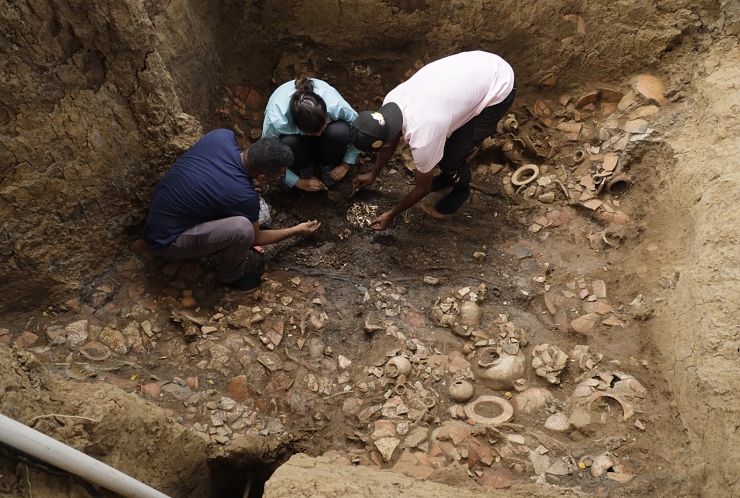Pěkný
Elite Indian tomb full of gold
Categories: Nálezy nejenom s detektorem kovů v USA, severní a jižní Americe
In Panama's El Caño Archaeological Park in the Natá district of Coclé province, a richly furnished tomb of a high-ranking Coclé culture man from the pre-Hispanic period has been discovered. The tomb dates from 750 to 800 and contains many sacrificial artifacts, including unique gold jewelry, several pectorals and many other objects of various materials...
The elaborately furnished burial chamber, marked No. 9, was discovered as part of a long-term archaeological project begun during the dry season in 2022. It belonged to an elite man, possibly a chief, who was buried face down on a female body, which was a common practice in this society and period.
A spectacular set of gold objects was found in the funerary equipment, including five gold pectorals, two pairs ofgold beaded bracelets, four bracelets, two anthropomorphic earrings with male and female images. Also, earrings in the form of a double crocodile, one necklace with small circular beads, five earringsgold-plated arachnid teeth, a set of gold plates, two bells, bracelets, a dog-tooth skirt and a set of bone flutes. And many ceramic vessels.
"The assemblage could have belonged to a high-ranking adult male among the chiefs," explained Dr. Julia Mayo, director of the El Caño Foundation, who has led the archaeological project for 18 years since the excavations began in 2008. "The tomb was built around 750 AD and is the grave of not only a high-ranking man, but also other people who died as his escorts to the afterlife," she said, adding the excavation of the tomb has not yet been completed, so it cannot be determined at this time how many people were buried with him.
The El Caño site, about 140 km southwest of Panama City, was discovered in the 1970s during agricultural activities. Subsequent archaeological investigations have uncovered burial mounds surrounded by massive upright stones. Monoliths also enclosed a ceremonial area with wooden buildings. The burial site belonged to a pre-Hispanic culture that inhabited much of the present-day province of Coclé from 200 BC to 1550 AD. The El Caño necropolis was built around 700 AD and abandoned 300 years later.
The latest discovery is not only important for its extremely rich assemblage, but also represents a special type of so-called Simultaneous burial, where after the death of a high-ranking man, other people were sacrificed to serve the deceased in the afterlife.
Roman Nemec
Sources: micultura.gob.pa, panama24horas.com.pa






The article is included in categories:
- Archive of articles > Archaeology > Finds and rescue research abroad > Nálezy nejenom s detektorem kovů v USA, severní a jižní Americe
Post
Kolosální!  Tak snad k dalšímu bádání nafasujou v muzeu pořádný boty!
Tak snad k dalšímu bádání nafasujou v muzeu pořádný boty! 
To Argill: tohle nosí celá jižní Amerika a taky Zukloš :)
Peťan taky chodí po dílně v puntíkatých ponožkách? 
Já na to koukal a myslel jsme že jsou to ty děrované plastové sandály :)
 Jo ták.
Jo ták.  Ovšem na kroksy taky nedám dopustit!☝️
Ovšem na kroksy taky nedám dopustit!☝️ 
Petr od konce března do listopadu... :)
U mě kroksová sezóna začíná začátkem března a končí s prvním sněhem.  Měl by jsi zvážit útrpné pracovní podmínky ve firmě a pouvažovat o podlahovém vytápění
Měl by jsi zvážit útrpné pracovní podmínky ve firmě a pouvažovat o podlahovém vytápění 


Sedíme v bývalé knihovně kláštera. Stěny mají cca. 1,5 metr kamene. Tady je zima i když venku padají mouchy vedrem :) Podlahovka nebude, pan domácí má velký kotel na dřevo a díky kůrovci na zahradě zásobu dřeva na 10 let 
Naštěstí se prodávají kroksy s kožíškem! 









